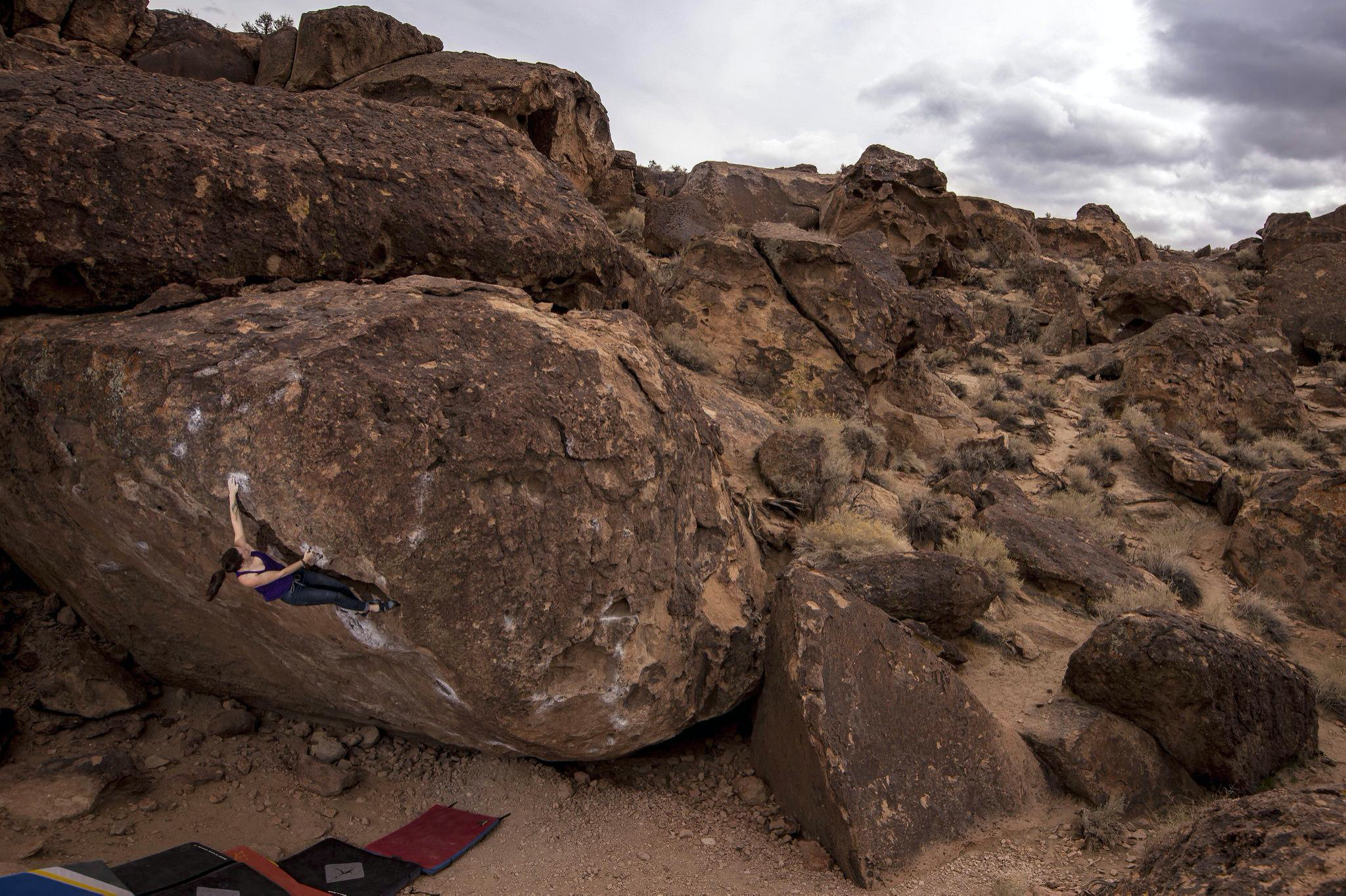
In the dramatic eastern foothills of California’s Sierra Nevada mountains, the alpine world abruptly gives way to desert—a desert that hosts a veritable oasis of outdoor adventure. Along the stunning U.S. Route 395, the once sleepy town of Bishop (with a population of about 3,800) has seen a revival of activity, mostly fueled by world-class bouldering. Each year, thousands of climbers make the pilgrimage to Bishop—roughly a four-hour drive from Los Angeles or 5-8 hours from San Francisco, transforming the silent landscape into a colorful playground of crash pads and athleticism. Here’s how to absolutely crush it on your first trip.
The Lay of the Land
Bishop’s 1,000-plus boulder problems are mostly concentrated in two key locales, the Buttermilks and the Volcanic Tablelands (also known as the Happy and Sad Boulders), making it easy for everyone, even first-timers, to get a solid feel for the place while packing in plenty of time on the rock.
The Buttermilks

It’s tough to think of a more famous and sought-after bouldering destination that the Buttermilks. What climber hasn’t seen the videos of Nina Williams sending highballs like Ambrosia (V11), or Alex Megos projecting Lucid Dreaming (V15)?
Tall, aesthetic lines on skin-shredding quartz monzonite challenge boulderers here with every technique in the book, from cranking on crimps to heel-hooking on huecos. While the notorious highball problems steal the limelight, hopping on High Plains Drifter (V7) isn’t the only way to put your skills to the test. Flat landings, densely clustered boulders, and a super social atmosphere make the Buttermilks ideal for pulling on lots of problems without a lot of hassle.
Here are some classics to check out on your inaugural trip:
- Hero Roof (V0)
- Buttermilk Stem (V1)
- The Womb “Birthing Experience” (V1)
- Monkey Dihedral (V2)
- Green Wall Essential (V2)
- Funky Tut (V3)
- King Tut (V3)
- Iron Man Traverse (V4)
- Bowling Pin (V4)
- Flyboy Arete (V5)
- Seven Spanish Angels (V6)
The Volcanic Tablelands

A few miles northwest of Bishop lies a massive volcanic mesa dotted with hundreds of boulders throughout its canyons. The two main areas, the Happy Boulders and the Sad Boulders, sit near one another and have similar climbing styles, though the Happys offer more in the way of V6 and easier problems.
The rock and the topography in the tablelands prove vastly different from the Buttermilks: both the Happys and the Sads feature generally shorter boulders of hard volcanic tuff sheltered in the canyons. Be prepared for plenty of gymnastic movement, thought-provoking traverses, and achievable highball problems. Pro tip: alternate days between the Tablelands and the Buttermilks to give shredded fingers a break from the sharp rock of the latter. Second pro tip: stay on the well-worn trails to avoid damaging the fragile desert plant life here—and in the Buttermilks, for that matter.
Don’t miss these classic problems:
- Celestial Trail (V0)
- China Doll (V0)
- The Sixty Foot Woman Traverse (V2)
- Still Life (V3)
- Monkey Hang (V3)
- Solarium (V4-)
- Ketron Classic (V4)
- Serengeti (V5)
- The Hulk (V6)
Lesser-Known Boulders Around Bishop
That’s right: The Buttermilks and the Volcanic Tablelands aren’t the only boulders in Bishop. For some solitude in lesser-visited areas, check out Druid Stones and Hurd Lake. Druid Stones is a convenient 10-minute drive from downtown, but there’s a 25- to 45-minute uphill approach. The payoff? More than 100 quality problems mostly V4 and below on the same quartz monzonite found at the Buttermilks.
Hurd Lake is a 40-minute drive from town, and it has a 40-minute approach, but you’re rewarded with stunning high-altitude scenery in the John Muir Wilderness. At Hurd Lake you’ll find hard granite, few climbers, and dozens of intriguing problems, making this beautiful spot worthwhile.
When to Go

October through March is the prime time for Bishop bouldering, with crisp temps and little precipitation. (During this time period there’s a chance of a dusting of snow even at the low altitudes of the Buttermilks and Volcanic Tablelands, but that won’t necessarily end your day.)
On stormy winter days, the canyons housing the Happy and Sad Boulders offer more shelter from the wind and slightly warmer temperatures than the Buttermilks. Summer hopefuls will find themselves chasing shade in Bishop’s stifling heat.
First-timers looking for a group introduction to the Bishop scene might want to plan a trip during one of the annual climbing festivals. The American Alpine Club comes to town each year in early November for the Bishop Fall Highball Craggin’ Classic, bringing together the local and visiting communities with climbing clinics, films, presentations, festivities brimming with local beer, and clean-up days at the boulders. In March, the Women’s Climbing Festival put on by Flash Foxy aims to connect female climbers from across the country through beginner clinics, gear demos, group meals, conversations, and stewardship projects.
Where to Stay
Every manner of tent-, truck- and van-dwelling climber can find budget camping at Pleasant Valley Pit Campground, close to the Volcanic Tablelands. When The Pit gets too busy, dispersed camping in designated National Forest and Bureau of Land Management areas provides an alternative for those who can dry camp and Leave No Trace. In-town accommodations run the gamut of hotels and motels, with the most climber-friendly option being the Hostel California.